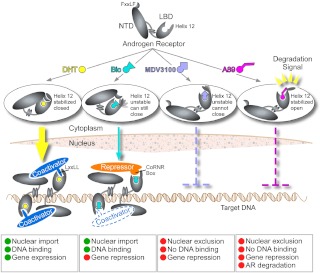Fig. 6.
Mechanisms of action for AR agonists and antagonists. Agonists stabilize a closed helix 12 position of the LBD that recruits the FxxLF motif of the NTD, resulting in AR N/C interaction, which facilitates AR nuclear import and DNA binding. Antagonists such as bicalutamide (Bic) do not stabilize helix 12 in a specific position and may allow a conformationally unstable helix 12 to transiently occupy the closed position and mediate AR nuclear import and DNA binding. However, this Bic-liganded AR preferentially recruits corepressors over coactivators. MDV3100 blocks helix 12 from closing, thereby preventing N/C interaction, nuclear import, and DNA binding. Chemotype A compounds stabilize helix 12 in a conformationally defined open position, preventing nuclear import and DNA binding. In addition, the positioning of helix 12 by chemotype A presents a degradation signal, resulting in increased AR degradation.

